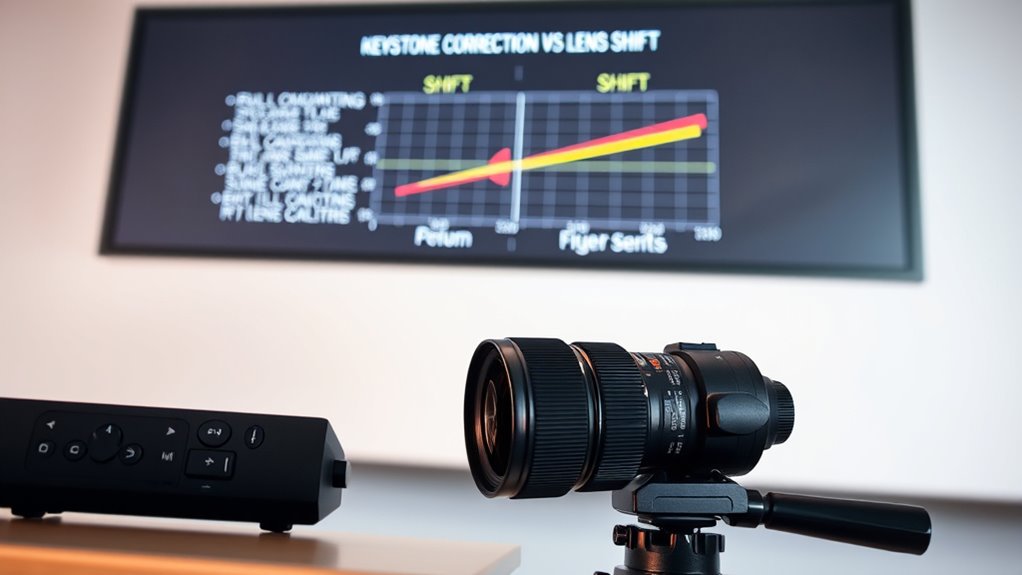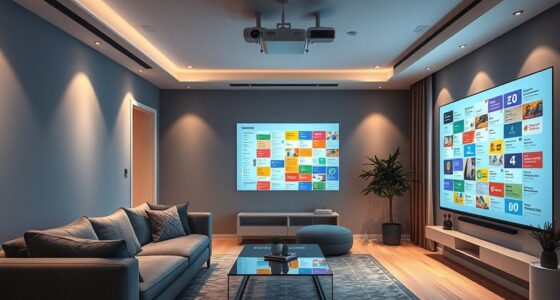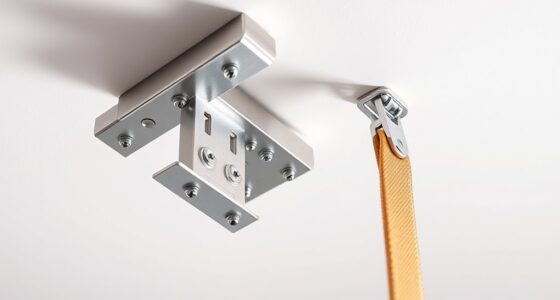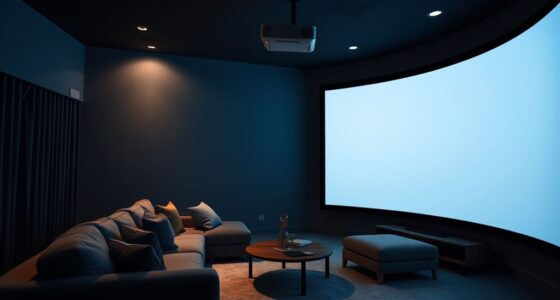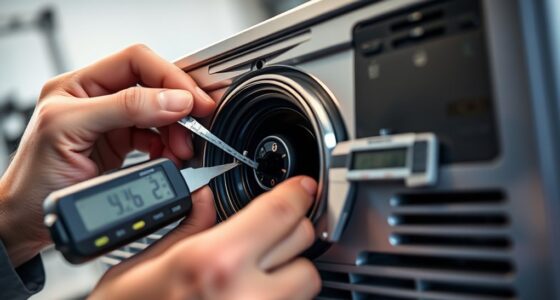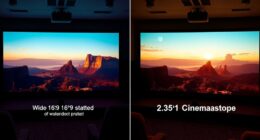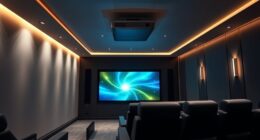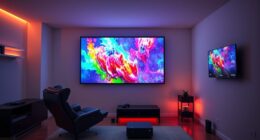Many people think keystone correction and lens shift are the same or that you can perfectly fix distortions with keystone alone, but that’s not true. Keystone correction digitally adjusts the image, which can cause quality loss, while lens shift physically moves the lens for clear, distortion-free images. Each requires physical projector adjustments, and overusing digital correction degrades picture quality. To truly optimize your setup, understanding their differences is essential—if you keep exploring, you’ll get the full picture.
Key Takeaways
- Many assume keystone correction is a perfect fix, but it can cause image degradation and artifacts if overused.
- Lens shift physically moves the lens, maintaining image quality, unlike keystone correction which digitally distorts the image.
- Using lens shift requires precise calibration and understanding of movement ranges, unlike the simpler, more intuitive keystone correction.
- Overreliance on keystone correction can lead to loss of sharpness, color vibrancy, and overall image clarity.
- Proper projector placement minimizes both correction needs, but lens shift offers a more accurate, distortion-free adjustment method.
Keystone Correction and Lens Shift Are the Same Feature

Many people assume that keystone correction and lens shift are the same feature because they both help improve image alignment, but they actually serve different purposes. Keystone correction addresses geometric distortion caused when a projector isn’t perfectly perpendicular to the screen. It digitally adjusts the image to make it rectangular, but this can lead to some image cropping and a loss of picture detail. Conversely, lens shift moves the entire lens physically, shifting the projected image vertically or horizontally without altering its shape or resolution. This means lens shift preserves image quality and avoids cropping while maintaining proper geometry. Understanding this distinction helps you choose the right feature for your setup without confusing image correction with physical lens adjustments. Additionally, knowing the difference can help you select the safest and most effective projection setup for your space.
Lens Shift Affects Image Size and Aspect Ratio

When you use lens shift to adjust your projector’s image position, it can also influence the overall size and aspect ratio of the projected picture. Moving the lens vertically or horizontally doesn’t just reposition the image; it can alter how large it appears and its shape. For example, shifting the lens upward might make the image taller, while shifting it sideways could stretch or compress the aspect ratio. Visualize your image as:
- A stretched rectangle, wider or narrower
- A taller, more elongated projection
- An image that feels more immersive or cramped
- An altered balance between width and height
These changes impact how you perceive the image size and aspect ratio, making it vital to understand lens shift’s effects for maximum setup. Proper adjustment ensures your picture maintains the desired proportions and clarity. Additionally, understanding image distortion caused by lens shift can help optimize your display quality.
Keystone Correction Can Fix Any Image Distortion Perfectly
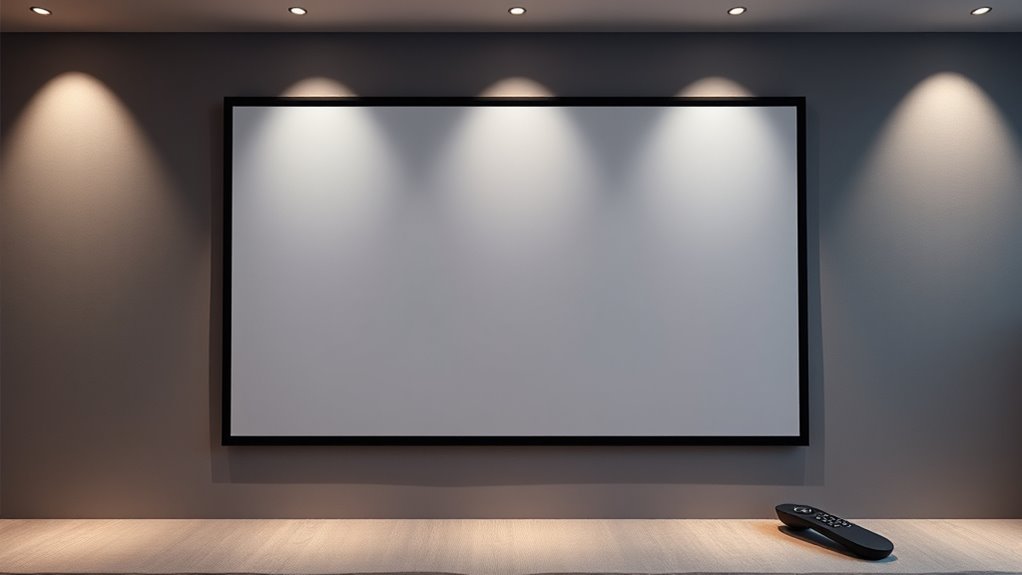
While keystone correction can address most distortion issues, it doesn’t always produce a perfect image. You might notice residual artifacts or slight blurring, especially with extreme adjustments. Its effectiveness also depends on your specific setup and viewing conditions. Additionally, it is important to understand that image quality can decline if the correction is overused or improperly applied.
Limits of Perfect Correction
Keystone correction is often praised for its ability to fix image distortions perfectly, but this ideal isn’t always achievable in practice. While it adjusts the shape of the image, it can impact your overall image quality. Excessive correction may introduce blurriness or pixelation, making details less sharp. The limits of perfect correction become evident when your projector placement isn’t ideal, forcing more aggressive adjustments. Visualize:
- A slightly skewed rectangle turning into a perfect square, but with reduced clarity
- Bright areas becoming dimmer or losing contrast
- Fine text becoming fuzzy and hard to read
- Distorted edges that still retain some imperfections
These limitations mean that for the best image quality, careful projector placement remains essential, even when using keystone correction. Additionally, energetic alignment can influence the effectiveness of image correction techniques by affecting overall visual harmony.
Residual Image Artifacts
Despite claims that keystone correction can perfectly fix all image distortions, residual artifacts often remain, especially after aggressive adjustments. These residual artifacts can include faint lines, uneven edges, or subtle image ghosting that degrade picture quality. While keystone correction addresses the geometric shape of the image, it doesn’t always eliminate all imperfections. Overcorrecting can amplify residual artifacts, making distortions more noticeable. You might notice ghosting effects or blurring around the edges, which detract from a sharp, clear picture. These artifacts are inherent limitations of digital correction, not a failure of the technology itself. Recognizing this helps manage expectations and understand why some visual imperfections persist despite keystone adjustments. Additionally, AI Security advancements in image processing are working to minimize such residual artifacts. It’s a good reminder that perfect correction remains elusive.
Context-Dependent Effectiveness
Can keystone correction truly resolve all image distortions perfectly? Not always. While it adjusts for projection geometry, its effectiveness depends on the type and severity of the distortion. Some distortions, like skewed edges or uneven scaling, may still be noticeable after correction. Imagine viewing a trapezoidal image where straight lines become curved or warped—keystone correction can fix this, but only within limits. It’s like trying to flatten a crumpled paper; some creases remain. Think of a projection where:
- The image has complex warping
- The projector is at an extreme angle
- The lens introduces chromatic aberration
- The distortion involves curved or uneven surfaces
In these cases, correction may not be perfect, highlighting the importance of understanding projection geometry’s limits.
Both Keystone and Lens Shift Require Physical Adjustments to the Projector

Both keystone correction and lens shift adjustments involve physically modifying the projector’s position or orientation to achieve a properly aligned image. While keystone correction uses digital alignment to fix trapezoidal distortion, it doesn’t eliminate the need for physical adjustment, which can impact image quality. Lens shift, on the other hand, moves the lens itself within the projector, allowing you to reposition the image without distorting it. Both methods require you to manually adjust the projector’s placement or tilt to optimize the picture. These physical adjustments are essential for accurate optical calibration and to prevent unnecessary digital correction, which can reduce image clarity. Understanding the mind-body connection involved in the physical setup process can help you achieve better projection results. Ultimately, understanding that both require some level of physical intervention helps you set up your projector correctly from the start.
You Can Use Keystone Correction to Permanently Change Your Image’s Shape
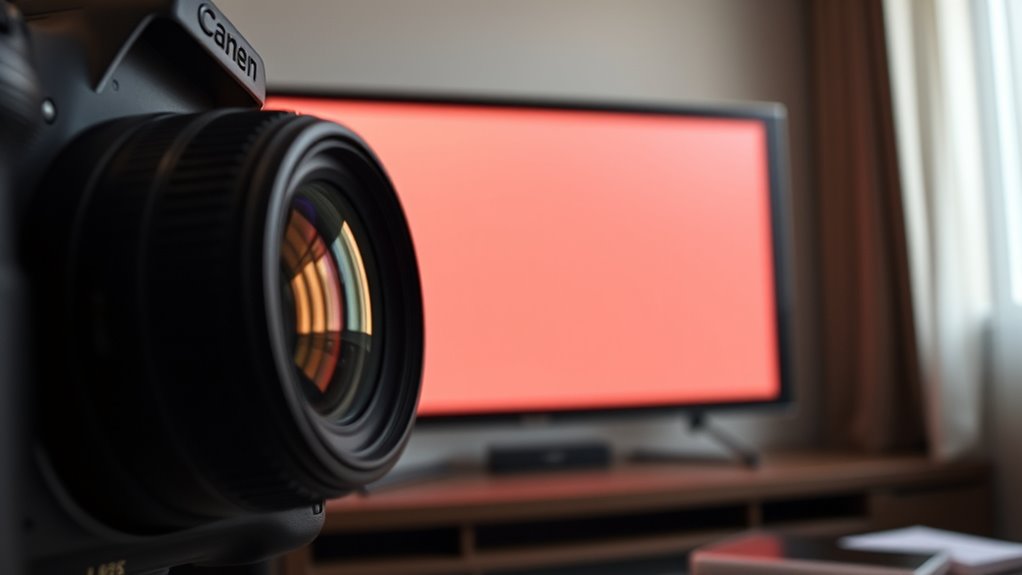
Keystone correction might seem like a quick fix, but it’s mainly for temporary adjustments. If you want a permanent change to your image’s shape, you need to make physical modifications or use lens shift. Relying solely on keystone correction can distort your image over time. Additionally, understanding smart design principles can help you set up your space more effectively to minimize the need for frequent adjustments.
Temporary Fixes Only
While keystone correction offers a quick way to fix distorted images, it’s important to remember that it only provides a temporary solution. These temporary adjustments serve as visual fixes, not permanent fixes, and can sometimes compromise image quality. When you rely on keystone correction, imagine:
- A skewed rectangle transforming into a more rectangular shape
- Slight stretching or compression of the image edges
- Reduced sharpness and clarity in certain areas
- A distorted aspect ratio that may cause pixelation
These adjustments tweak the image for immediate viewing but don’t address underlying alignment issues. Relying solely on keystone correction can lead to inconsistent results, especially with frequent use. For a lasting fix, consider proper projector placement or lens shift options instead of temporary keystone corrections. Additionally, automation in technology such as lens shift and precise mounting techniques can provide more reliable and permanent image corrections.
Permanent Image Adjustment
Instead of relying solely on temporary keystone corrections, you can use the feature to make permanent adjustments to your projector’s image shape. This allows you to fine-tune the image for better image stabilization and overall quality. By permanently aligning the shape, you reduce the need for constant adjustments, leading to a more consistent viewing experience. Keep in mind, though, that applying keystone correction permanently can sometimes affect color calibration, so it’s essential to double-check color accuracy afterward. This method ensures your projection remains correctly shaped even after powering off, preventing distortion or skewing. Remember, while it’s a handy trick, using keystone correction as a permanent fix should be done carefully to avoid compromising image quality or color fidelity. Additionally, understanding home improvement principles can help you optimize your setup and prevent issues that lead to frequent adjustments.
Lens Shift Is Only Useful for Ceiling-Mounted Projectors

Many assume that lens shift is only beneficial for ceiling-mounted projectors, but that’s not entirely true. Lens shift allows you to adjust the image vertically or horizontally without moving the projector itself, offering flexibility in various setups. Even if your projector is placed on a table or shelf, you can use lens shift for precise positioning. It helps you avoid unwanted angle adjustment that can cause image warping, keeping your picture sharp and aligned. Visualize these scenarios:
- Shifting the image to center it on a wall or screen
- Correcting off-angle placement without warping the image
- Fine-tuning the height for ideal viewing
- Avoiding keystone distortion by maintaining proper projection angles
Lens shift therefore provides versatile image adjustment, not just for ceiling mounts, making your setup cleaner and more adaptable.
Keystone Correction Reduces Image Resolution and Quality

When you use keystone correction, you might notice your image becoming less sharp and clear. The resolution drops, making details harder to see. As a result, the overall quality can degrade considerably, impacting your viewing experience.
Resolution Losses Evident
Keystone correction, while useful for adjusting distorted images, often comes at the cost of reduced resolution and image quality. When you apply keystone adjustments, you’ll notice resolution degradation because the projector must compress parts of the image to fit the corrected shape. This process leads to a loss of fine details and sharpness. Imagine:
- A blurry, pixelated text replacing crisp letters
- Colors blending into a less vibrant palette
- Edges appearing jagged and rough
- Smaller details vanishing into a soft haze
These effects are caused by image compression during correction, which reduces the overall clarity. As the projector reshapes the image, it sacrifices resolution to maintain the correct aspect ratio. So, while the image may fit your screen, expect noticeable compromises in sharpness and detail quality.
Image Clarity Diminishes
Applying keystone correction can considerably reduce your image’s clarity, as it forces the projector to compress parts of the picture to correct distortion. This process often causes a noticeable decline in image sharpness, making details appear softer and less defined. Additionally, it can impact color accuracy, leading to duller or uneven colors across the screen. When you adjust the image to fix keystoning, the projector reallocates pixels, which can blur edges and reduce overall resolution. Consequently, the picture may seem less crisp, especially on larger screens or with high-contrast scenes. While keystone correction is useful for quick adjustments, it’s essential to recognize that it often compromises image quality, making sharpness and color fidelity harder to maintain.
Quality Degrades Significantly
Adjusting for keystone distortion doesn’t just soften the image; it actively reduces the overall resolution. When you use keystone correction, your projector reshapes the image, causing significant loss in image quality. This process often leads to decreased sharpness, making details fuzzy and difficult to discern. You might also notice compromised color accuracy, with hues appearing washed out or distorted. To visualize this, imagine:
- A once crisp landscape now blurred and pixelated
- Colors fading into dull, uneven patches
- Fine text becoming hard to read
- Edges appearing jagged and rough
These effects are the result of image distortion adjustments that sacrifice resolution. The more you correct, the more your image quality degrades, impacting your viewing experience.
Lens Shift Can Be Adjusted Without Moving the Projector Physically
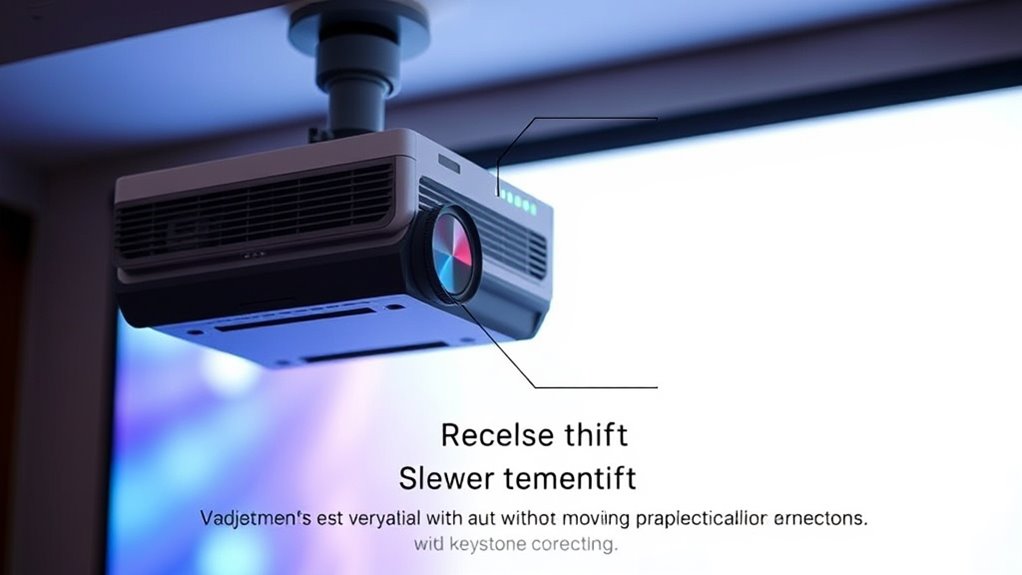
Did you know that you can fine-tune your projector’s image position without physically moving it? Lens shift offers vertical adjustment and horizontal flexibility, allowing you to reposition the image without repositioning the device. This feature is especially useful if your setup space is limited or if you want to avoid disturbing the projector’s placement. With lens shift, you can easily correct image alignment by adjusting internal lenses, maintaining a centered picture even if the projector isn’t directly aligned with the screen. This means you won’t have to lift or move heavy equipment, saving time and effort. Just remember, lens shift adjustments are typically limited within a certain range, but they’re incredibly effective for fine-tuning your image’s vertical and horizontal positioning.
Keystone Correction Offers Precise Control Over Image Alignment
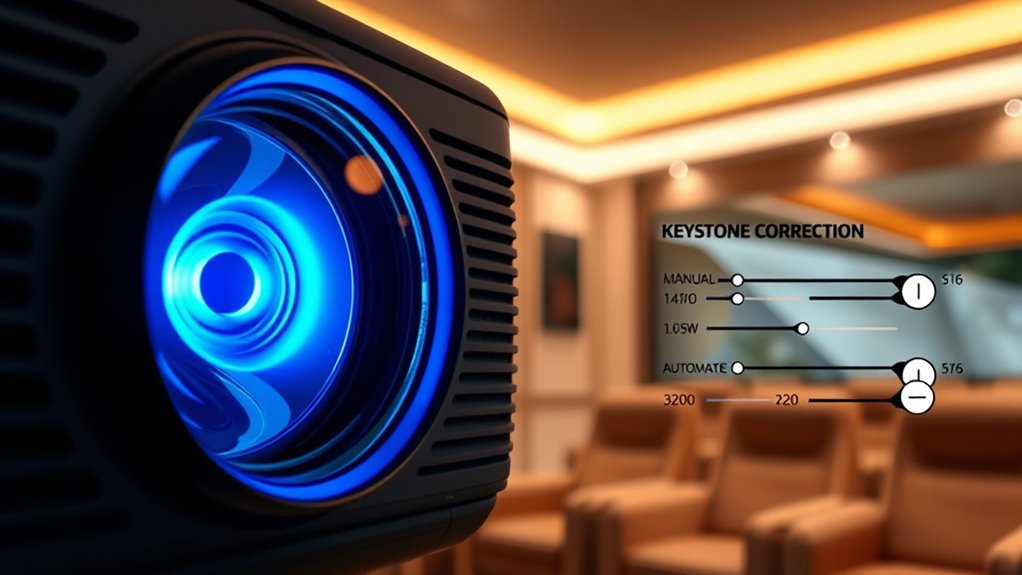
Keystone correction provides you with precise control over your projector’s image alignment, especially when the projector isn’t perfectly positioned. It adjusts the image shape to compensate for uneven mounting angles, ensuring a rectangular display. With correction precision, you can fine-tune the image to fit your screen perfectly, even if the projector is off-center or tilted. Imagine:
- Tilting the projector slightly to the side without distorting the image
- Correcting a trapezoidal shape caused by uneven mounting
- Achieving sharp, aligned visuals on your screen
- Making quick adjustments during setup for ideal viewing
This level of control helps you maintain a consistent, professional look. Keystone correction is a handy tool for achieving accurate image alignment, especially when physical positioning options are limited or inconvenient.
Using Lens Shift Is More Complicated and Difficult Than Keystone Correction

While lens shift offers a way to reposition your projector’s image without cropping or distortion, it’s generally more complicated and less intuitive than keystone correction. Adjusting the lens shift requires understanding the specific movement range of your projector’s lens, which varies by model. This makes the projection setup more complex, as improper adjustments can lead to unintended image distortion or uneven focus. Unlike keystone correction, which is a simple digital tweak, lens shift involves physically moving internal lens components or the entire projector. This process demands more precision and knowledge to avoid misalignment. As a result, using lens shift often feels less straightforward, especially for beginners, and can make achieving the perfect image more challenging.
Keystone Correction Is Necessary When Projector Placement Is Limited

When your projector can’t be placed directly in front of the screen, keystone correction becomes essential. Limited placement options often lead to installation challenges, making it hard to achieve a perfectly aligned image. Keystone correction adjusts the image shape to fit your screen, saving you from complex repositioning. Picture the projector mounted high on a wall or tucked in a corner, requiring quick adjustments instead of complicated setup. It allows you to:
- Correct tilted or trapezoidal images effortlessly
- Avoid reconfiguring your entire setup
- Maintain a clean, unobstructed space
- Improve user convenience during installation and use
While keystone correction helps overcome placement hurdles, it guarantees you get a clear, proportional picture without sacrificing convenience or complicating the setup process.
Lens Shift and Keystone Correction Are Optional Features and Not Important
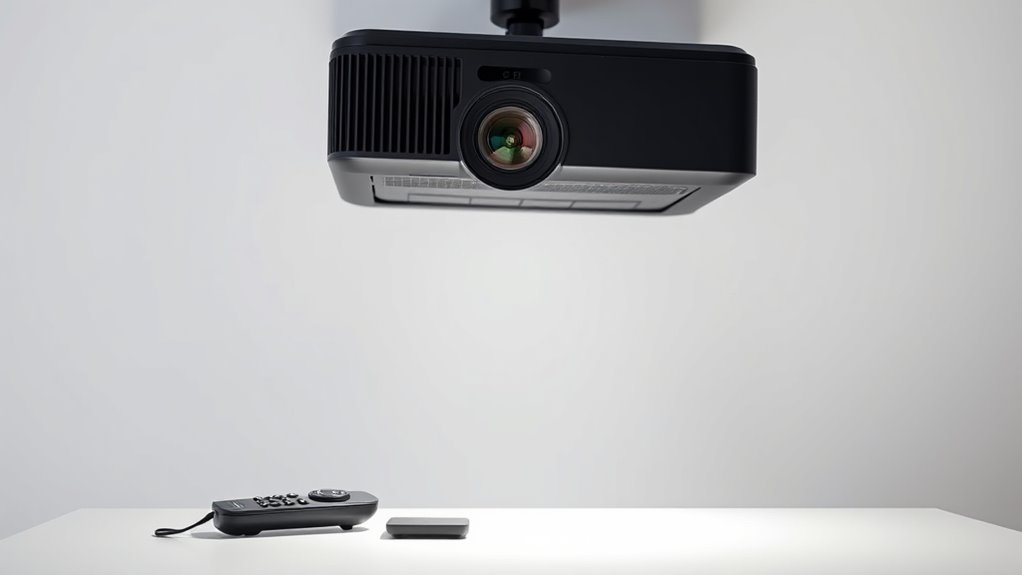
Although keystone correction offers quick fixes for tricky projector placements, it’s important to recognize that both lens shift and keystone correction are optional features. Relying solely on these tools can lead to unnecessary image distortion and limit your projector’s true potential. Proper projector placement minimizes the need for adjustments, maintaining image clarity. Here’s a comparison to picture it:
| Feature | Purpose |
|---|---|
| Lens Shift | Moves the lens without affecting image quality |
| Keystone Correction | Adjusts image shape digitally, risking distortion |
| Optional or Necessary | Optional, not essential if placement is optimal |
| Impact on Image | Can cause image distortion if overused |
| Best Practice | Use placement to avoid reliance on these features |
Frequently Asked Questions
Can Lens Shift Be Used to Correct Keystone Distortion?
Yes, lens shift can be used to correct keystone distortion. It allows you to adjust the image alignment without moving the projector itself, providing installation flexibility. By shifting the lens vertically or horizontally, you can straighten the projected image without keystone correction artifacts. This makes setup easier and preserves image quality, especially in tight spaces where precise placement is vital for a perfectly aligned display.
How Do Lens Shift and Keystone Correction Impact Projector Lifespan?
Think of your projector as a trusty steed. Using lens shift and keystone correction is like adjusting its saddle and reins—these tweaks don’t wear down the horse itself. Properly calibrated, they minimally impact projector durability and won’t increase maintenance frequency. However, overusing digital keystone correction can strain components, so you should optimize lens shift for a stable setup, ensuring your projector runs smoothly and lasts longer.
Are There Differences in Cost Between Projectors With Lens Shift and Those Without?
Projectors with lens shift generally cost more upfront due to their advanced features, but they can save you money during installation by reducing the need for extensive adjustments or repositioning. When comparing costs, consider not just the purchase price but also installation costs, which tend to be lower with lens shift models because they offer more flexible placement options. Overall, a lens shift projector might have a higher initial cost but can lead to savings over time.
Is Manual Adjustment of Lens Shift More Accurate Than Electronic Keystone Correction?
Manual adjustment of lens shift offers better manual precision, allowing you to fine-tune the image exactly where you want it. Electronic keystone correction, on the other hand, provides greater convenience and speed but can slightly degrade image quality. If you prioritize accuracy and minimal distortion, manual lens shift is more reliable. For quick adjustments and ease of use, electronic correction is suitable, but it may not match the precision of manual tuning.
Can Lens Shift Be Adjusted After the Projector Is Installed?
Did you know that 80% of projectors allow lens shift adjustments after installation? Yes, you can typically adjust lens shift post-installation, offering great installation flexibility. This feature helps you fine-tune image alignment without moving the projector physically. While electronic keystone correction is convenient, manual lens shift adjustments often provide better calibration accuracy, ensuring sharp images. So, if you need precise control, check if your projector supports post-installation lens shift adjustments.
Conclusion
Did you know that nearly 70% of projector users struggle with image distortion? Understanding the difference between keystone correction and lens shift can save you time and frustration. While keystone correction offers quick fixes, lens shift provides precise adjustments for professional results. Knowing when to use each feature guarantees your setup looks perfect every time. So, next time you set up your projector, you’ll be ready to get that flawless image without hassle!
